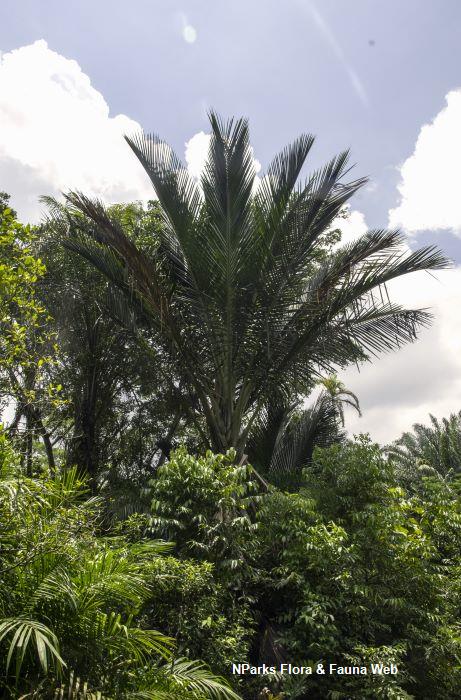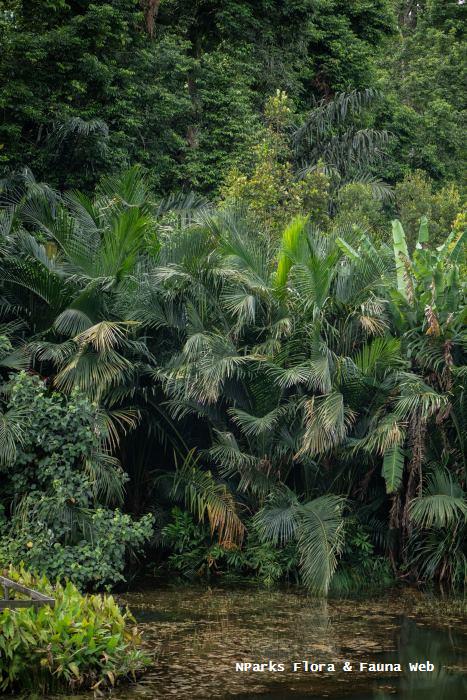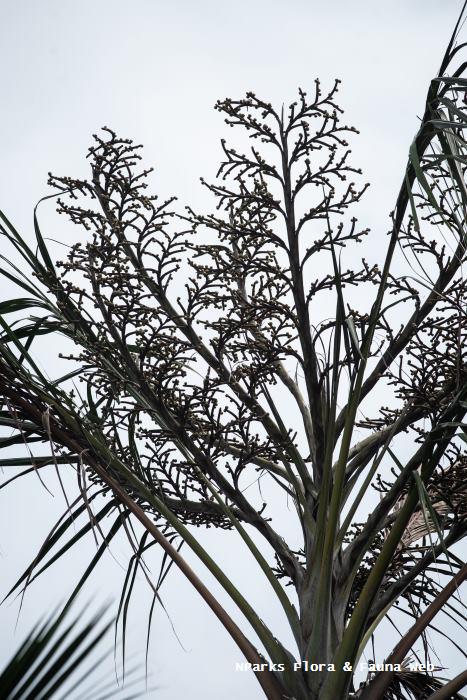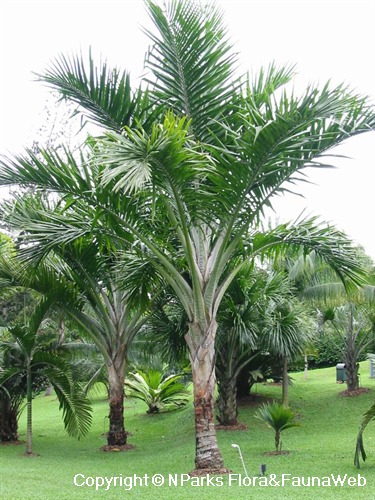
Back
Metroxylon sagu Rottb.
| Family Name: | Arecaceae (Palmae) |
| Synonyms: | Metroxylon hermaphroditum Hassk., Metroxylon rumphii (Willd.) Mart., Metroxylon laeve (Giseke) Mart., Metroxylon squarrosum Becc., Metroxylon sago K.D.Koenig, Sagus sagu (Rottb.) H.Karst. |
| Common Name: | True Sago Palm, Sago Palm, Smooth Sago Palm |
Metroxylon sagu, or commonly known as True Sago Palm, is a robust, clustering palm that can grow up to 20 metres tall. It produces large pinnate fronds with collars of spines on the petioles and leaf sheaths. Widely cultivated throughout Southeast Asia, this palm species is an important source of sago starch, which is extracted from the pith of the trunk. This fast-growing palm thrives in unfavourable soil conditions, showing high tolerant to waterlogging, saline soil, and poor, infertile soil.
Name
Classifications and Characteristics
| Plant Division | Angiosperms (Flowering Seed Plants) (Monocotyledon) |
|---|---|
| Plant Growth Form | Palm (Clustered Habit) |
| Lifespan (in Singapore) | Perennial |
| Mode of Nutrition | Autotrophic |
| Plant Shape | Fountain (Palm-like) |
| Maximum Height | 20 m |
Biogeography
| Native Distribution | Moluccas Islands and New Guinea |
|---|---|
| Native Habitat | Terrestrial (Freshwater Swamp Forest, Disturbed Area / Open Ground) |
| Preferred Climate Zone | Tropical |
| Local Conservation Status | Non-native (Horticultural / Cultivated Only) |
Description and Ethnobotany
| Growth Form | It is a robust, single to multi-stemmed palm, up to 20 m tall. |
|---|---|
| Crown | Each crown holds above 11 - 16 fronds. |
| Trunk | The trunk can reach 35 - 45 cm in diameter with internodes reaching 8 - 14 cm long. |
| Roots | Short, spine-like adventitious roots can be found near the lower portion of the stems. |
| Foliage | The fronds are large (about 8 m long including petiole), semi-erect, and even-pinnately compound with 60 - 77 leaflets on either side of the rachis. The leaflets are usually armed with marginal spines. The apical leaflets are 45 - 47 × 1 - 1.5 cm wide and not united, and the rest of the leaflets are 122 - 146 × 5 - 11 cm wide. The petiole is 2.7 m long. The petiole and leaf sheath can be unarmed or armed with spines up to 5 cm long, arranged in collars and often detaching and leaving persistent ridges of united spine bases. Both rachis, petiole and sheath are covered in a dense, white, scaly coating. |
| Flowers | The inflorescence is a panicle, growing terminally above the crown of fronds, up to 3 - 7 m tall. The penduncle (main stalk on inflorescence) reaches up to 1.5 m tall). The inflorescence branches up to 3 orders: 15 - 30 upwardly curving first-order branches are arranged spirally, with each having 15 - 25 rigid, distichous(in two opposite rows) second-order branches. Each second-order branch has 10 - 12 rigid, distichously arranged catkin-like rachillae (minor, secondary axes on inflorescences), up to 8 – 14 × 1.1 – 1.6 cm long. Each rachillae is made up of several pairs of male and bisexual flowers, of which male flowers open before the bisexual flowers. The flowers are orange-red with 6 stamens, 3-lobed calyx and 3-lobed corolla. The filaments are united at the base, forming a tube around the ovary in bisexual flowers. This species is hapaxanthic or monocarpic, meaning that the palm perishes after producing flowers and fruits. |
| Fruit | The fruit is a globose drupe, 30 - 40 mm × 31 - 46 mm in diameter, and covered in yellowish-golden imbricate scales. Each drupe produces a single seed, measuring 20 - 25 mm × 23 - 33 mm in diameter. |
| Habitat | It can be found in swamp forests, coastal plains, floodplains of rivers, and flat valley floors, including disturbed habitats, where it often occurs in vast stands, typically at very low elevations, up to 1,200 m above sea level. |
| Associated Fauna | The flowers are pollinated by insects, predominantly by bees, wasps and beetles. In New Guinea, the fruit are eaten by the Northern Cassowary (Casuarius unappendiculatus). |
| Cultivation | This species is adaptable to unfavourable soil conditions, such as waterlogging, high acidity, high salinity, and low fertility. It is propagated by suckers and seeds. |
| Etymology | The genus Metroxylon is derived from the Greek words metra, "heart/womb", and xylon "wood", referring to the rich, starchy pith found in the trunk of these palms. The specific epithet sagu is from the Javanese word sago, which describes the starch-rich pith of the palm. |
| Ethnobotanical Uses | Edible Plant Parts : Edible Stems Food (Fruit or Vegetable): In New Guinea, young shoots are consumed as vegetables. |
Landscaping Features
| Desirable Plant Features | Ornamental Form |
|---|---|
| Landscape Uses | Parks & Gardens, Marsh / Bog, Pond / Lake / River, Focal Plant |
| Thematic Landscaping | Economic Garden, Marsh Garden |
| Usage Hazard - Cons | Spines/Thorns - Leaf |
| Usage Hazard - Cons Remarks | Spines/Thorns (Leaf): the petioles and leaf sheath are armed with spines up to 5 cm long, arranged in multiple collars. |
Fauna, Pollination and Dispersal
| Pollination Method(s) | Biotic (Fauna) (Insects (Ant, Beetle, Fly, Thrip, Wasp), Insects (Bee)) |
|---|---|
| Seed or Spore Dispersal | Biotic (Fauna) |
Plant Care and Propagation
| Light Preference | Full Sun |
|---|---|
| Water Preference | Moderate Water, Lots of Water |
| Plant Growth Rate | Fast |
| Rootzone Tolerance | Fertile Loamy Soils, Heavy Clay Soils, Waterlogged Soils, Saline Soils / Salt Spray, Poor Infertile Soils |
| Pest(s) | Chewing Insects |
| Propagation Method | Sucker, Seed |
Foliar
| Foliage Retention | Evergreen |
|---|---|
| Mature Foliage Colour(s) | Green, Silver / Grey |
| Mature Foliage Texture(s) | Powdery / Waxy Bloom, Spiny / Bristly / Stinging |
| Foliar Type | Compound (Even-Pinnate) |
| Foliar Arrangement Along Stem | Spiral |
| Foliar Attachment to Stem | Petiolate |
| Foliar Shape(s) | Palm Fronds (Pinnate / Feather) |
| Leaf Area Index (LAI) for Green Plot Ratio | 4.0 (Palm - Cluster) |
Non - Foliar and Storage
| Trunk Type (Palm) | Clustering Habit, Aboveground |
|---|---|
| Root Type | Underground (Fibrous Root), Aboveground (Aerial Root) |
Floral (Angiosperm)
| Flower & Plant Sexuality | Bisexual Flowers |
| Flower Colour(s) | Orange |
|---|---|
| Flower Grouping | Cluster / Inflorescence |
| Flower Location | Terminal |
| Flower Symmetry | Radial |
| Inflorescence Type | Spike, Panicle |
| Flowering Habit | Monocarpic |
Fruit, Seed and Spore
| Mature Fruit Colour(s) | Yellow / Golden |
|---|---|
| Mature Fruit Texture(s) | Scaly |
| Fruit Classification | Simple Fruit |
| Fruit Type | |
| Mature Seed Colour(s) | Black |
| Seed Quantity Per Fruit | Few (1-5) |
References
| References | Jong, F.S. (2002). Flowering and Pollination in Sago Palms (Metroxylon sagu Rottb.): A Review. SAGO PALM 10: 24 - 29. |
|---|
Image Repository
Others
| Master ID | 30132 |
|---|---|
| Species ID | 4441 |
| Flora Disclaimer | The information in this website has been compiled from reliable sources, such as reference works on medicinal plants. It is not a substitute for medical advice or treatment and NParks does not purport to provide any medical advice. Readers should always consult his/her physician before using or consuming a plant for medicinal purposes. |








